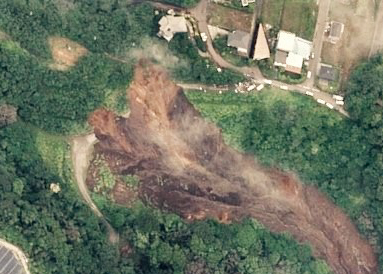Atami 2021: “The Mudslide Ruins Were the Largest I’ve Ever Witnessed”

You don’t expect your life to end suddenly on a rainy Saturday morning, puttering around at home. To have earth and water and debris careen down a slope and slam into, through your home. You barely have time to realize what’s happening. And then it’s over.
***
High up in the hills above Atami, rainwater finished infiltrating the nearly 56,000 cubic meters of soil and debris that had been packed into the head of the valley. Unable to drain, the water instead saturated the fill, putting intense pressure on unconsolidated particles and causing the mass to lose its cohesion, a condition called static liquefaction.
No longer strong enough to win its battle against gravity, the mass abruptly slid downslope, into the stream channel. Beginning as a normal landslide, it rapidly transitioned into a channelized debris flow within the confining walls of the valley. It incorporated river water, trees, rocks, soil, and previous landslide deposits into itself, churning everything together into a dense, massive wall of destruction. Nothing could stop or slow it as it bore down upon Atami. And wherever it passed, devastation followed.
***
Survivors noticed strange things. A rotten smell, wet earth, a “chemical stench.” A horrible, thunderous, rumbling noise. A vibration that made electricity pylons shake. They looked up the mountain, and saw a tsunami of mud and debris at least five meters high coursing down the slope and into the river. There wasn’t time to grab belongings, or go back for loved ones: just a desperate scramble out of windows and doors and a frantic dash for higher ground.
The flow filled the normally narrow river and spilled over its banks, creating a channel dozens of meters wide. It engulfed houses, crushing walls, battering them with cars it had picked up. 131 structures were damaged, destroyed, or swept completely away. Two victims were carried, dead, into the sea. In moments, it ended, and the Izusan neighborhood, beloved for its hot springs, lovely residences, its shrine, and its shopping district lay broken and buried by mud.

Detail of mudslide debris in residential area. Made based on aerial image by National Land Image Information (Color Aerial Photographs), Ministry of Land, Infrastructure, Transport and Tourism
***
Japan is no stranger to mudslides, especially now that forests are being cut for wood, development has expanded, and the fragile balance that allows steep slopes to maintain a standoff with gravity has been upset. The country has experienced an average of 1,500 landslides every year for the past decade, up from around 750 per year in the decade prior. But Atami, with its large and unmonitored valley fill, its residential development, and its solar farm all in the same fragile drainage area, was particularly ripe for disaster.
“Filling in a valley is similar to constructing a dam,” Professor Toshitaka Kami of Kyoto University said. “Unless a measure is taken to release water from the landfill, it could lead to a landslide should the embankment collapse after becoming filled with water.”
If measures were taken to appropriately drain the valley fill, they were sorely inadequate to the task. You can’t just leave it at piling in dirt: water still collects there, and will weaken the integrity of the pile if allowed to saturate it. Especially in an era when anthropogenic climate change causes more intense summer rains, your drain game needs to be on point. Especially when you’ve accidently captured a river.
Geologist Kunio Shiosaka of the Japan Society of Civil Engineers was at first perplexed when he visited the site of the disaster. “The mudslide ruins were the largest I’d ever witnessed,” he said. He saw a large amount of water running out of the debris. He was perplexed: despite the heavy rains, none of it seemed possible. The drainage basin of the Aizome River, which is above the fill area and would have delivered the bulk of the water to the slide area, is fairly small.
“There’s no way a mudslide would occur from rainfall collected in a 40,000 square meter range alone,” Shiosaka said. So he went looking for answers.
He found his answers on the ridge that had once separated the 200,000 m² watershed of the Narusama River from the Aizome River basin. Construction had destroyed the barrier and drastically changed drainage patterns. “The mountain ridge was flattened during development. This is an artificial river capture.”
He also found that water draining from the developed area immediately around the fill had drained into it, compounding the problem. “Water accumulated within the mounds of soil, and groundwater also entered it, resulting in buoyancy that triggered the collapse.”
So many factors, many of them predictable, had combined into a massive disaster.
***
An estimated 85% of the artificial fill failed and flowed downslope. Three months later, the death toll stands at 23. Four people are still missing. 131 homes and buildings were hit; almost half of them were destroyed, and hundreds of people left homeless. Atami is left with masses of mud and debris to clean up, with limited options for safely storing it.
Tragic stories like this will only become more common as climate change compounds with human encroachment into fragile landscapes. We can’t complely prevent the ensuing disasters. But we have ways to mitigate them. Will we have the political will to ensure that proper regulations are passed and enforced, and resources devoted to prevention, mitigation, and preparedness?
Rosetta Stones and Dana Hunter’s Unconformity wouldn’t be possible without you! If you like my content, there are many ways to show your support.
This website is a member of the Amazon Affiliates program. I get a small commission when you use my affiliate link to make a purchase.



